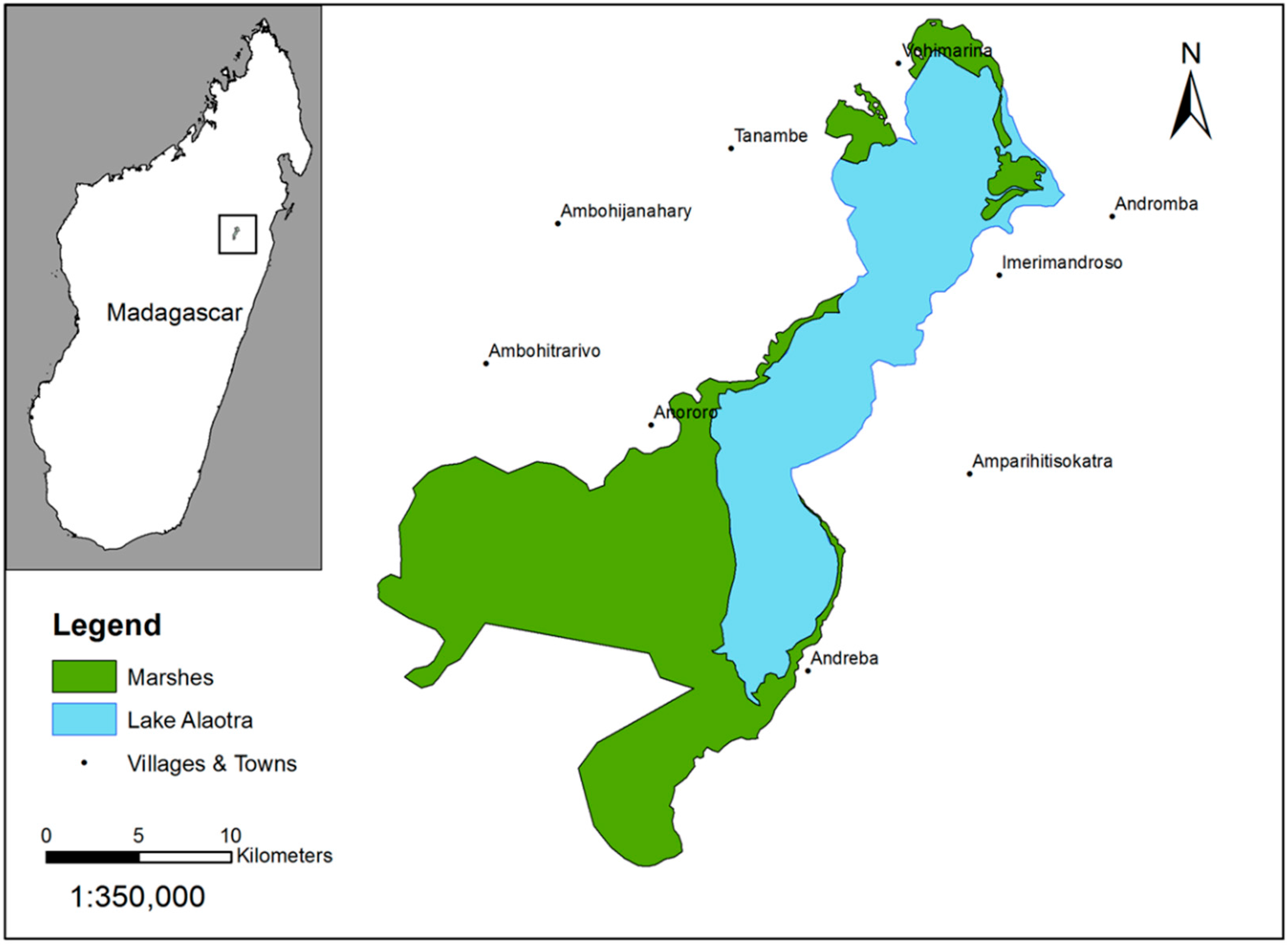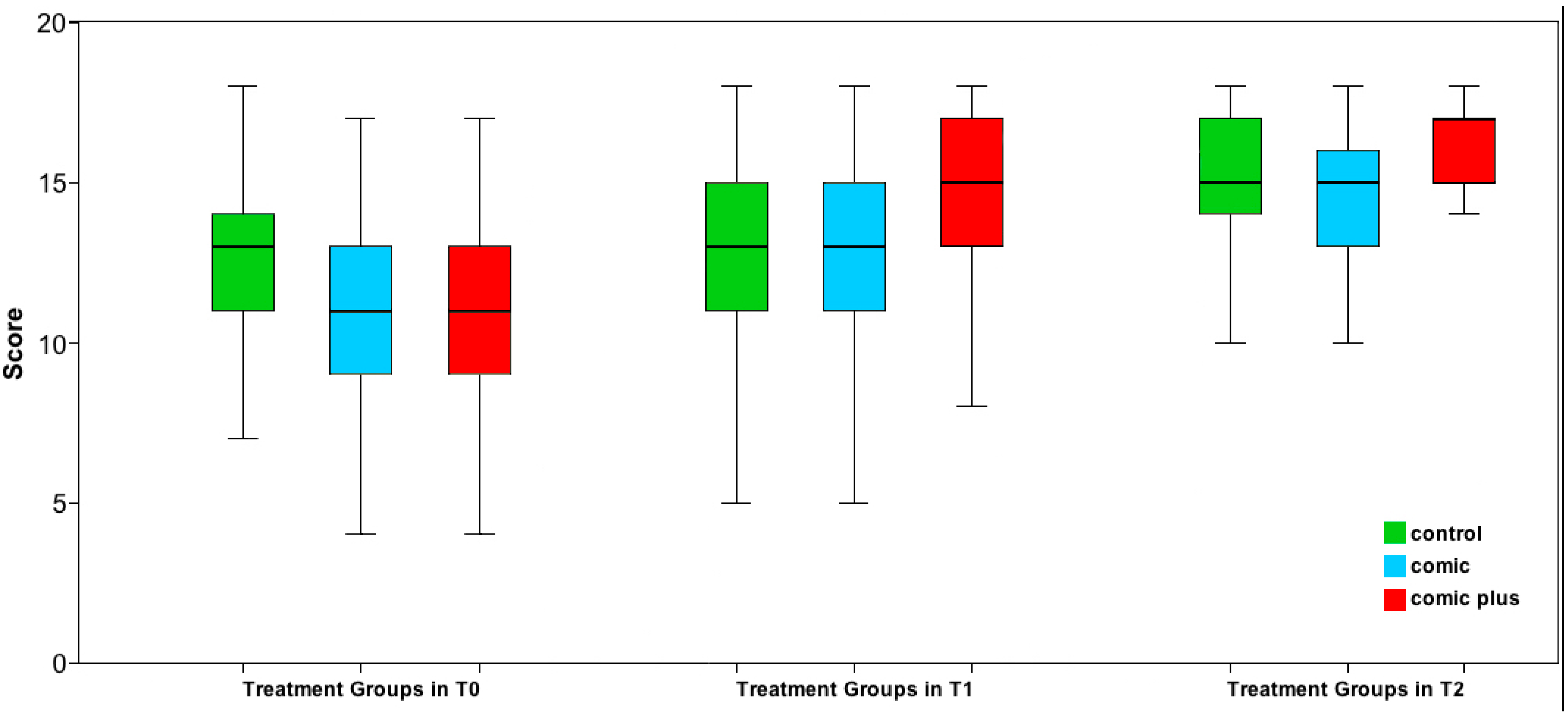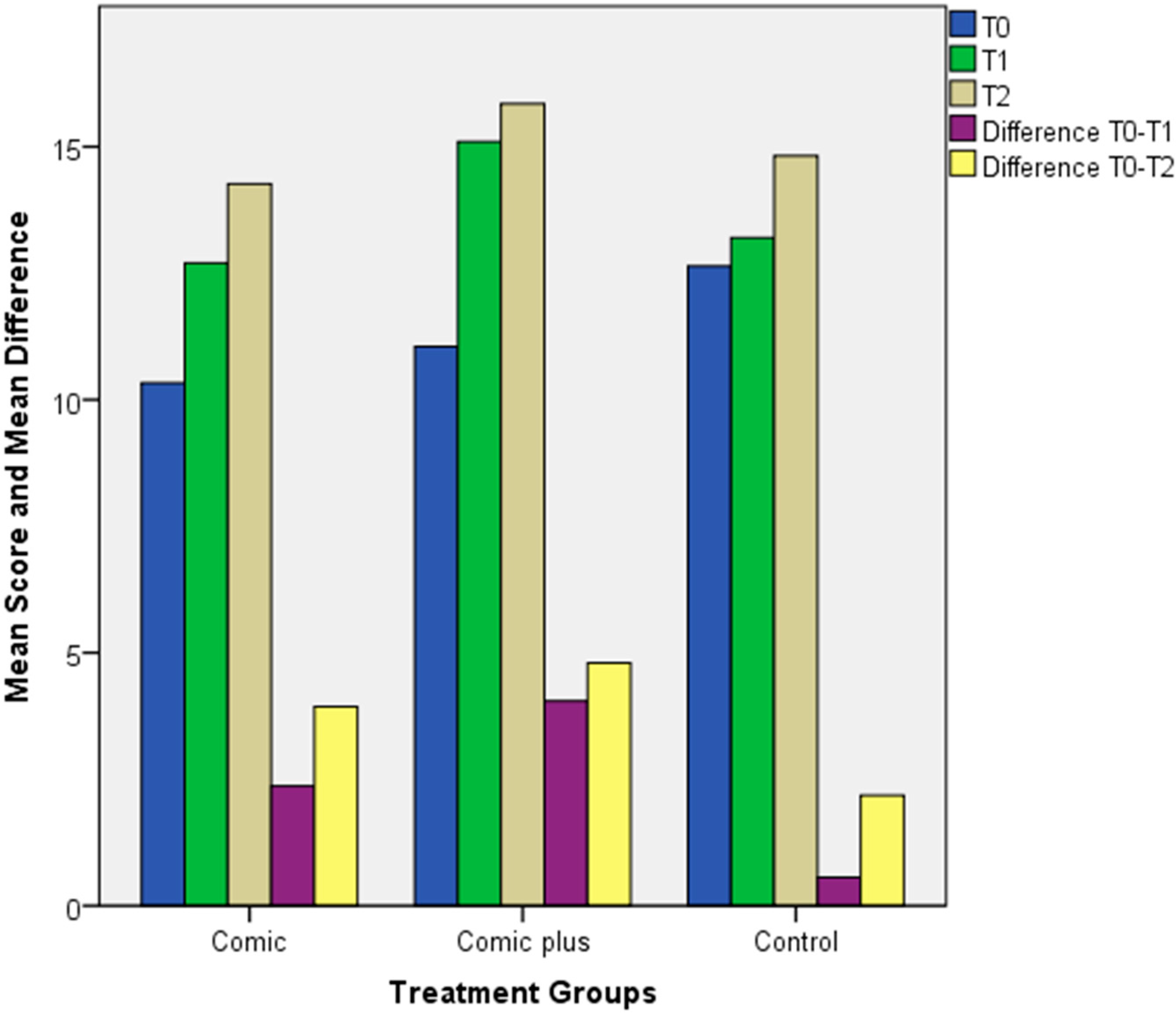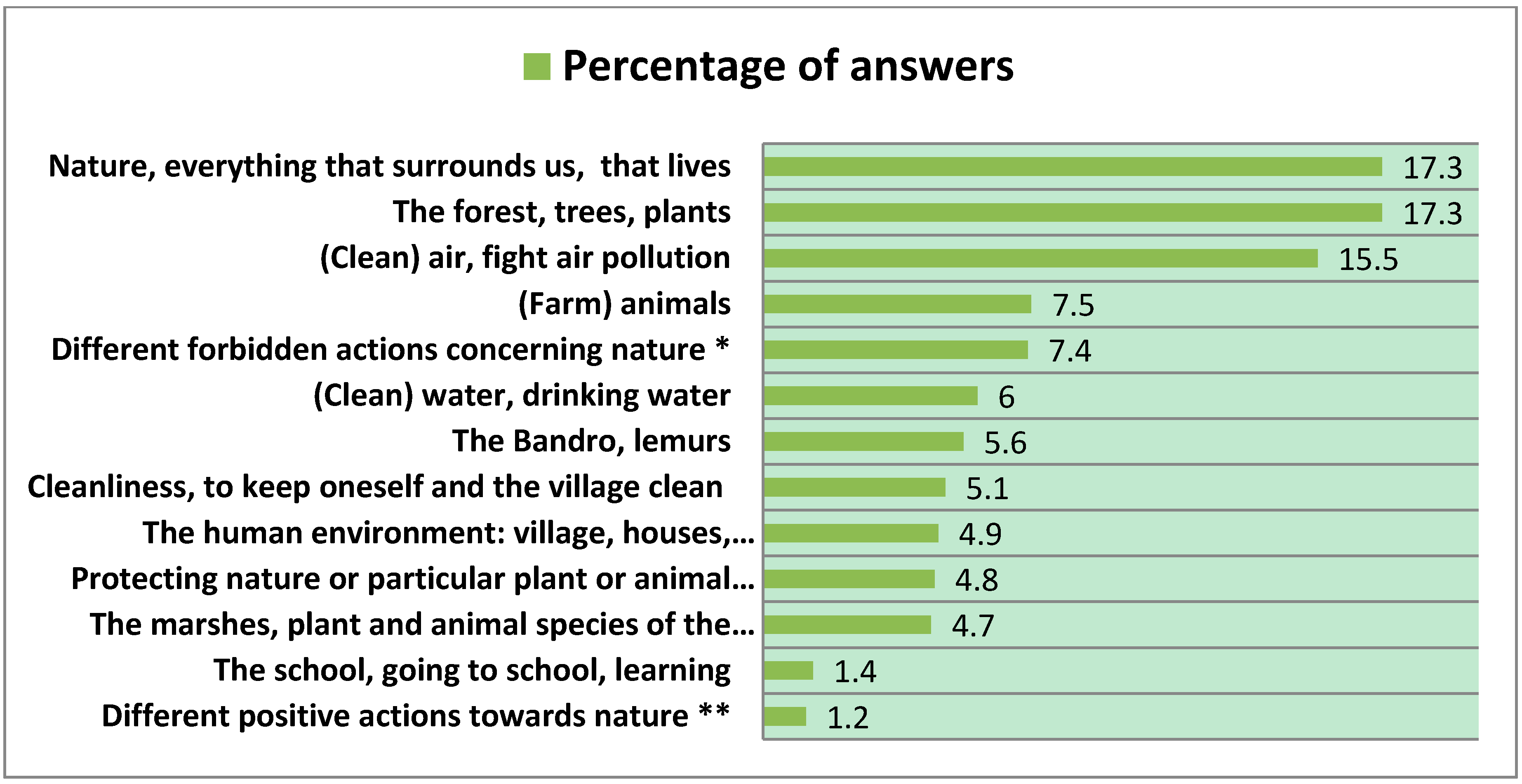Conservation Messages in Speech Bubbles–Evaluation of an Environmental Education Comic Distributed in Elementary Schools in Madagascar
Abstract
:1. Introduction
1.1. Madagascar, Lake Alaotra and Its Marshlands
1.2. The Marshlands of Lake Alaotra

1.3. Education and Environmental Education in Madagascar
2. Experimental Section
2.1. Teacher Training
2.2. Educational Material
2.2.1. Comic Book
2.2.2. Additional Educational Materials
3. Results and Discussion
3.1. Results

| ANOVA T0: Score | |||||
|---|---|---|---|---|---|
| Source | Sum of squares | df | Mean square | F | Sig. |
| Between | 434.206 | 2 | 217.103 | 29.418 | 0.000 |
| Within | 3970.341 | 538 | 7.380 | ||
| Total | 4404.547 | 540 | |||
| ANOVA T1: Score | |||||
| Source | Sum of squares | df | Mean square | F | Sig. |
| Between | 335,619 | 2 | 167.809 | 22.843 | 0.000 |
| Within | 3783.310 | 515 | 7.346 | ||
| Total | 4118.929 | 517 | |||
| ANOVA T2: Score | |||||
| Source | Sum of squares | df | Mean square | F | Sig. |
| Between | 52.765 | 2 | 26.382 | 766 | 0.001 |
| Within | 865.698 | 222 | 3900 | ||
| Total | 918.462 | 224 | |||

| Survey time | Control | Comic | Comic Plus |
|---|---|---|---|
| T0 (542) | 12.42 ± 2.592 (253) | 10.76 ± 2.831 (139) | 10.51 ± 2.813 (149) |
| T1 (518) | 12.80 ± 2.895 (247) | 13.03 ± 2.664 (136) | 14.70 ± 2.388 (135) |
| T2 (224) | 15.06 ± 1.866 (108) | 14.39 ± 2.121 (79) | 15.79 ± 1.961 (38) |
3.1.1. Open Questions

3.1.2. Career Aspirations
| T0 (n = 489) | T1 (n = 485) | T2 (n = 219) | Percentage of all answers | |||||||||
|---|---|---|---|---|---|---|---|---|---|---|---|---|
| Career aspiration | Girls | Boys | All | Girls | Boys | All | Girls | Boys | All | T0 | T1 | T2 |
| Teacher | 95 | 79 | 174 | 105 | 59 | 164 | 60 | 32 | 92 | 35.7 | 33.8 | 42.0 |
| Doctor | 41 | 37 | 78 | 40 | 33 | 73 | 17 | 23 | 40 | 16.0 | 15.1 | 18.3 |
| Rice/Vegetable Farmer | 29 | 45 | 74 | 12 | 25 | 37 | 7 | 9 | 16 | 15.2 | 7.6 | 7.3 |
| Nun/Priest | 20 | 7 | 27 | 49 | 10 | 59 | 9 | 4 | 13 | 5.5 | 12.2 | 5.9 |
| Fisher | 2 | 25 | 27 | 2 | 16 | 18 | 1 | 4 | 5 | 5.5 | 3.7 | 2.3 |
| Help the parents | 16 | 5 | 21 | 4 | - | 4 | 3 | - | 3 | 4.3 | 0.8 | 1.4 |
| Policeman/Soldier | 1 | 16 | 17 | 10 | 63 | 73 | 3 | 26 | 29 | 3.5 | 15.1 | 13.3 |
| Protector of marshes | 1 | 4 | 5 | 4 | 10 | 14 | 4 | 3 | 7 | 1.0 | 2.9 | 3.2 |
3.2. Discussion
4. Conclusions
Supplementary Files
Supplementary File 1Acknowledgments
Author Contributions
Conflicts of Interest
References
- Horning, N.R. Strong support for weak performance: Donor competition in Madagascar. Afr. Affairs 2008, 107, 405–431. [Google Scholar] [CrossRef]
- UNDP Human Development Report 2014: Sustaining Human Progress: Reducing Vulnerabilities and Building Resilience. Available online: http://hdr.undp.org/en (accessed on 25 February 2015).
- International Monetary Fund. World Economic Outlook Database. April 2008. Available online: www.imf.org (accessed on 12 February 2015).
- UNDP Human Development Report 2014: Sustaining Human Progress: Reducing Vulnerabilities and Building Resilience–Explanatory note on the 2014 HDR composite inidices–Madagascar. Available online: http://hdr.undp.org/en (accessed on 25 February 2015).
- Glick, P.; Sahn, D.E. The demand for primary schooling in Madagascar: Price, quality, and the choice between public and private providers. J. Dev. Econ. 2006, 79, 118–145. [Google Scholar] [CrossRef]
- Reibelt, L.M.; Richter, T.; Waeber, P.O.; Rakotoarimanana, S.H.N.H.; Jasmin Mantilla-Contreras, J. Environmental education in its infancy at Lake Alaotra, Madagascar. Madag. Conserv. Dev. 2014, 9, 71–82. [Google Scholar]
- CIA World Fact Book 2015. Available online: https://www.cia.gov/library/publications/the-world-factbook/ (accessed on 13 March 2015).
- Shepherd, A.; Mitchell, T.; Lewis, K.; Lenhardt, A.; Jones, L.; Scott, L.; Muir-Wood, R. The Geography of Poverty, Disasters and Climate Extremes in 2030; ODI: London, UK, 2013. [Google Scholar]
- Randrianja, S. (Ed.) Madagascar, le coup d’État de mars 2009; Éditions Karthala: Paris, France, 2012.
- Stokstad, E. Despite progress, biodiversity declines. Science 2010, 329, 1272–1273. [Google Scholar] [CrossRef] [PubMed]
- Green, G.; Sussman, R. Deforestation history of the eastern rain forests of Madagascar from satellite images. Science 1990, 248, 212–215. [Google Scholar] [CrossRef] [PubMed]
- Glaw, F.; Vences, M. A Field Guide to the Amphibians and Reptiles of Madagascar, 3rd ed.; Vences & Glaw: Cologne, Germany, 2007. [Google Scholar]
- Vieites, D.R.; Wollenberg, K.C.; Andreone, F.; Köhler, J.; Glaw, F.; Vences, M. Vast underestimation of Madagascar’s biodiversity evidenced by an integrative amphibian inventory. Proc. Natl. Acad. Sci. USA 2009, 106, 8267–8272. [Google Scholar] [CrossRef] [PubMed]
- Mittermeier, R.A.; Gil, P.R.; Pilgrim, J. Hotspots Revisited: Earth’s Biologically Richest and Most Endangered Terrestrial Ecoregions; Conservation International: Arlington, VA, USA, 2005. [Google Scholar]
- Myers, N.; Mittermeier, R.A.; Mittermeier, C.G.; da Fonseca, G.A.B.; Kent, J. Biodiversity hotspots for conservation priorities. Nature 2000, 403, 853–858. [Google Scholar] [CrossRef] [PubMed]
- Rakotomanana, H.; Jenkins, R.K.B.; Ratsimbazafy, J. Conservation challenges for Madagascar in the next decade. In Conservation Biology–Voices from the Tropics; Sodhi, N.S., Gibson, L., Raven, P.H., Eds.; Wiley-Blackwell: Hoboken, NJ, USA, 2013; pp. 33–39. [Google Scholar]
- Rendigs, A.; Reibelt, L.M.; Ralainasolo, F.B.; Ratsimbazafy, J.H.; Waeber, P.O. Ten years into the marshes–Hapalemur alaotrensis conservation, one step forward and two steps back? Madag. Conserv. Dev. 2015, 10, 13–20. [Google Scholar]
- Hannah, L.; Dave, R.; Lowry, P.P.; Andelman, S.; Andrianarisata, M.; Andriamaro, L.; Cameron, A.; Hijmans, R.; Kremen, C.; Mackinnon, J.; et al. Climate change adaptation for conservation in Madagascar. Biol. Lett. 2008, 4, 590–594. [Google Scholar] [CrossRef] [PubMed]
- Institut National de la Statistique. 2012. Available online: http://www.instat.mg/index.php?option=com_content&view=article&id=33&Itemid=56 (accessed on 18 January 2014).
- Bakoarininiaina, L.N.; Kusky, T.; Raharimahefa, T. Disappearing Lake Alaotra: Monitoring catastrophic erosion, waterway silting, and land degradation hazards in Madagascar using Landsat imagery. J. Afr. Earth Sci. 2006, 44, 241–252. [Google Scholar] [CrossRef]
- Andrianandrasana, H.T.; Randriamahefasoa, J.; Durbin, J.; Lewis, R.E.; Ratsimbazafy, J.H. Participatory ecological monitoring of the Alaotra wetlands in Madagascar. Biodivers. Conserv. 2005, 14, 2757–2774. [Google Scholar] [CrossRef]
- Rakotoarisoa, T.; Waeber, P.O.; Richter, T.; Mantilla-Contreras, J. Water hyacinth (Eichhornia crassipes), opportunity or threat for the Alaotra wetlands and livelihood? Madag. Conserv. Dev. 2015, in press. [Google Scholar]
- Dolins, F.L.; Jolly, A.; Rasamimanana, H.; Ratsimbazafy, J.; Feistner, A.T.; Ravoavy, F. Conservation education in Madagascar: Three case studies in the biologically diverse island-continent. Am. J. Primatol. 2010, 72, 391–406. [Google Scholar] [CrossRef] [PubMed]
- Copsey, J.A.; Jones, J.P.G.; Andrianandrasana, H.; Rajaonarison, L.H.; Fa, J.E. Burning to fish: Local explanations for wetland burning in Lac Alaotra, Madagascar. Oryx 2009, 43, 403–406. [Google Scholar] [CrossRef]
- Copsey, J.A.; Rajaonarison, L.H.; Ranriamihamina, R.; Rakotoniaina, L.J. Voices from the marsh: Livelihood concerns of fishers and rice cultivators in the Alaotra wetland. Madag. Conserv. Dev. 2009, 4, 25–30. [Google Scholar] [CrossRef]
- Ranarijoana, H.L.T. Concept de Modéle Ecologique pour la Zone Humide Alaotra. Madag. Conserv. Dev. 2007, 2, 35–42. [Google Scholar] [CrossRef]
- Lammers, P.; Richter, T.; Waeber, P.O.; Mantilla-Contreras, J. Lake Alaotra wetlands: Ecological status quo in one of Madagascar’s most important rice and fish production regions. Madag. Conserv. Dev. 2015, in press. [Google Scholar]
- Villamagna, A.M.; Murphy, B.R. Ecological and socio-economic impacts of invasive water hyacinth (Eichhornia crassipes): A review. Freshw. Biol. 2010, 55, 282–298. [Google Scholar] [CrossRef]
- Ferry, L.; Mietton, M.; Robison, L.; Erismann, L. Le lac Alaotra a Madagascar-Passe, Present et Futur. Z Geomorphol. 2009, 53, 299–318. [Google Scholar] [CrossRef]
- Penot, E.; Benz, H.; Bar, M. Utilisation d’indicateurs économiques pertinents pour l’évaluation des systèmes de production agricoles en termes de résilience, vulnérabilité et durabilité: Le cas de la région du lac Alaotra à Madagascar. Ėthique et écon. 2014, 11, 44–60. [Google Scholar]
- Plan Régional de Développement; Région Alaotra-Mangoro, Province Autonome de Toamasina. 2005; unpublished work.
- Pidgeon, M. An Ecological Survey of Lake Alaotra and Selected Wetlands of Central and Eastern Madagascar in Analyzing the Demise of Madagascar Pochard Aythya Innotata; WWF/Missouri Botanical Garden: Antananarivo, Madagascar, 1996. [Google Scholar]
- Durbin, J.; Funk, S.M.; Hawkins, F.; Hills, D.M.; Jenkins, P.D.; Moncrieff, C.B.; Ralainasolo, F.B. Investigations into the status of a new taxon of Salanoia (Mammalia: Carnivora: Eupleridae) from the marshes of Lac Alaotra, Madagascar. Syst. Biodivers. 2010, 8, 341–355. [Google Scholar] [CrossRef]
- The IUCN Red List of Threatened Species. Aythya Innotata. Available online: http://www.iucnredlist.org/details/9676/0 (accessed on 18 January 2014).
- Guillera-Arroita, G.; Lahoz-Monfort, J.J.; Milner-Gulland, E.J.; Young, R.P.; Nicholson, N. Monitoring and conservation of the Critically Endangered Alaotran gentle lemur Hapalemur alaotrensis. Madag. Conserv. Dev. 2010, 5, 103–109. [Google Scholar] [CrossRef]
- Guillera-Arroita, G.; Lahoz-Monfort, J.J.; Milner-Gulland, E.J.; Young, R.P.; Nicholson, E. Using occupancy as a state variable for monitoring the Critically Endangered Alaotran gentle lemur Hapalemur alaotrensis. Endanger. Spec. Res. 2010, 11, 157–166. [Google Scholar] [CrossRef]
- Ratsimbazafy, J.H.; Ralainasolo, F.B.; Rendigs, A.; Mantilla-Contreras, J.; Andrianandrasana, H.; Mandimbihasina, A.R.; Nievergelt, C.M.; Lewis, R.; Waeber, P.O. Gone in a puff of smoke? Hapalemur alaotrensis at great risk of extinction. Lemur News 2013, 17, 14–18. [Google Scholar]
- Ralainasolo, F.B.; Waeber, P.O.; Ratsimbazafy, J.; Durbin, J.; Lewis, R. The Alaotra gentle lemur: Population estimation and subsequent implications. Madag. Conserv. Dev. 2006, 1, 9–10. [Google Scholar]
- The IUCN Red List of Threatened Species. Version 2014.3. Available online: http://www.iucnredlist.org/details/22680380/0 (accessed on 13 March 2015).
- Ramsar Convention Secretariat. The Ramsar Convention Manual: A Guide to the Convention on Wetlands (Ramsar, Iran, 1971), 6th ed.; Ramsar Convention Secretariat: Gland, Switzerland, 2013. [Google Scholar]
- Hart, E. Identification of key characteristics of environmental education. J. Environ. Educ. 1981, 13, 12–16. [Google Scholar] [CrossRef]
- Palmer, J.A. Environmental Education in the 21st Century: Theory, Practice Progress and Promise; Routledge: London, UK, 2003. [Google Scholar]
- UNESCO. Trends in Environmental Education; UNESCO: Paris, France, 1977. [Google Scholar]
- UNESCO. Final Report: Intergovernmental Conference on Environmental Education; UNESCO: Paris, France, 1978. [Google Scholar]
- Orr, D.W. Earth in Mind; Island Press: Washington, DC, USA, 1994. [Google Scholar]
- UNESCO. Proposal for a Global Action Programme on Education for Sustainable Development as Follow-Up to the United Nations Decade of Education for Sustainable Development (DESD) after 2014; UNESCO: Paris, France, 2013. [Google Scholar]
- Pavlova, M.B. Environmental education and/or education for sustainable development: What role for technology education? In PATT 25, CRIPT 8–Perspectives on Learning in Design & Technology Education; Stables, K., Benson, C., de Vries, M., Eds.; Goldsmiths University of London: London, UK, 2011; pp. 333–339. [Google Scholar]
- Kopnina, H. Revisiting Education for Sustainable Development (ESD): Examining Anthropogenic Bias Through the Transition of Environmental Education to ESD. Sustain. Dev. 2011, 22, 73–83. [Google Scholar] [CrossRef]
- Kopnina, H. Education for sustainable development (ESD): The turn away from “environment” in environmental education? Environ. Educ. Res. 2012, 18, 699–717. [Google Scholar] [CrossRef]
- Frick, J.; Kaiser, F.G.; Wilson, M. Environmental knowledge and conservation behavior: Exploring prevalence and structure in a representative sample. Pers. Indiv. Differ. 2004, 37, 1597–1613. [Google Scholar] [CrossRef]
- Kaiser, F.G.; Fuhrer, U. Ecological behavior’s dependency on different forms of knowledge. Appl. Psychol.-Int. Rev. 2003, 52, 598–613. [Google Scholar] [CrossRef]
- Roczen, N.; Kaiser, F.G.; Bogner, F.X.; Wilson, M. A Competence Model for Environmental Education. Environ. Behav. 2014, 46, 972–992. [Google Scholar] [CrossRef]
- Bogner, F.X.; Wiseman, M. Adolescents’ attitudes towards nature and environment: Quantifying the 2-MEV model. Environmentalist 2006, 26, 247–254. [Google Scholar] [CrossRef]
- Geiger, S.M.; Otto, S.; Diaz-Marin, J.S. A diagnostic Environmental Knowledge Scale for Latin America. Psyecol. Biling. J. Environ. Psychol. 2014, 5, 1–36. [Google Scholar]
- Liefländer, A.K.; Bogner, F.X.; Kibbe, A.; Kaiser, F.G. Evaluating Environmental Knowledge Dimension Convergence to Asses Educational Programme Effectiveness. Int. J. Sci. Educ. 2015, 37, 684–702. [Google Scholar] [CrossRef]
- Jolly, A. Challenges of Environmental Education in Madagascar. In Proceedings of the Conference Environmental Education in Madagascar, University of Sussex, Brighton, UK, 27–28 January 2012.
- Patel, E.R.; Marshall, J.J.; Parathian, H. Silky sifaka (Propithecus candidus) conservation education in northeastern Madagascar. Lab. Primate Newsl. 2005, 44, 8–11. [Google Scholar]
- Korhonen, K.; Lappalainen, A. Examining the environmental awareness of children and adolescents in the Ranomafana region, Madagascar. Environ. Educ. Res. 2004, 10, 195–216. [Google Scholar] [CrossRef]
- Ratsimbazafy, J.H. Lemurs as the most appropriate and best didactic tool for teaching. Lemur News 2003, 8, 19–21. [Google Scholar]
- Brown, C. UNICEF initiatives in Madagascar. In Proceedings of the conference Environmental Education in Madagascar, University of Sussex, Brighton, UK, 27–28 January 2012.
- Cowlishaw, G.; Dunbar, R. Primate Conservation Biology; University of Chicago Press: Chicago, IL, USA, 2000. [Google Scholar]
- Ferraro, P.J.; Pattanayak, S.K. Money for Nothing? A Call for Empirical Evaluation of Biodiversity Conservation Investments. PLoS Biol. 2006, 4, 482–488. [Google Scholar]
- Carleton-Hug, A.; Hug, J.W. Challenges and opportunities for evaluating environmental education programs. Eval. Program Plan. 2010, 33, 159–164. [Google Scholar] [CrossRef] [PubMed]
- Stern, M.J.; Powell, R.B.; Hill, D. Environmental education program evaluation in the new millenium: What do we measure and what have we learned? Environ. Educ. Res. 2014, 20, 581–611. [Google Scholar] [CrossRef]
- Ajiboye, J.O.; Olatundun, S.A. Impact of Some Environmental Education Outdoor Activities on Nigerian Primary Schools Pupils’ Environmental Knowledge. Appl. Environ. Educ. Commun. 2010, 9, 149–158. [Google Scholar] [CrossRef]
- Bettinger, T.L.; Kuhar, C.W.; Lehnhardt, K.; Cox, D.; Cress, D. Discovering the Unexpected: Lessons Learned From Evaluating Conservation Education Programs in Africa. Am. J. Primatol. 2010, 72, 445–449. [Google Scholar] [CrossRef] [PubMed]
- Krief, S.; Nambogwe, H.; Mankoto, S.; Krief, J.-M. Malles pédagogiques itinérantes «les grands singes et leur habitat«: Parcours et premières évaluations de l’impact du projet en Ouganda et au Gabon. Available online: http://primatologie.revues.org/383 (accessed on 24 February 2015).
- Kuhar, C.W.; Bettinger, T.L.; Lehnhardt, K.; Tracy, O.; Cox, D. Evaluating for Long-Term Impact of an Environmental Education Program at the Kalinzu Forest Reserve, Uganda. Am. J. Primatol. 2010, 72, 407–413. [Google Scholar] [CrossRef] [PubMed]
- Kuhar, C.W.; Bettinger, T.L.; Lehnhardt, K.; Cartwright, B.; Cress, D. Education Program Evaluation at Multiple Primate Sanctuaries in Equatorial Africa. Int. J. Primatol. 2012, 33, 208–217. [Google Scholar] [CrossRef]
- Johnson-Pynn, J.S.; Johnson, L.R. Successes and Challenges in East African Conservation Education. J. Environ. Educ. 2005, 36, 25–39. [Google Scholar] [CrossRef]
- Borchers, C.; Boesch, C.; Riedel, J.; Guilahoux, H.; Outtara, D.; Randler, C. Environmental Education in Côte d’Ivoire/West Africa: Extra-Curricular Primary School Teaching Shows Positive Impact on Environmental Knowledge and Attitudes. Int. J. Sci. Educ. 2014, 4, 240–259. [Google Scholar] [CrossRef]
- Keane, A.; Ramarolahy, A.A.; Jones, J.P.G.; Milner-Gulland, E.J. Evidence for the effects of environmental engagement and education on knowledge of wildlife laws in Madagascar. Conserv. Lett. 2011, 4, 55–63. [Google Scholar] [CrossRef]
- Ormsby, A. Development of Environmental Education Programs for Protected Areas in Madagascar. Appl. Environ. Educ. Commun. 2007, 6, 223–232. [Google Scholar] [CrossRef]
- Jacobson, S.K. Conservation education programs: Evaluate and improve them. Environ. Conserv. 1987, 14, 201–205. [Google Scholar] [CrossRef]
- Maminirina, C.P.; Girod, P.; Waeber, P.O. Comic strips as environmental educative tools for the Alaotra Region. Madag. Conserv. Dev. 2006, 1, 11–14. [Google Scholar] [CrossRef]
- Cassiau-Haurie, C. La Bande Dessinée dans l’océan indien. Festival de bande dessinée de l’Île Maurice: Îles en bulles. 2006. Available online: http://eprints.aidenligne-francais-universite.auf.org/339/1/Iles_en_bulles.pdf (accessed on 18 February 2015).
- Ravelontsalama, N. Représentations et fonctions de la bande dessinée à Madagascar. Études Océan indien 2008, 40–41, 256–268. [Google Scholar] [CrossRef]
- Anderson, L.W.; Krathwohl, D.R. (Eds.) A Taxonomy for Learning, Teaching and Assessing: A Revision of Bloom’s Taxonomy of Educational Objectives; Longman: New York, NY, USA, 2001.
- Krathwohl, D.R. A Revision of Bloom’s Taxonomy: An Overview. Theory Pract. 2002, 41, 212–218. [Google Scholar] [CrossRef]
- Monroe, M.C.; Andrews, E.; Biedenweg, K. A Framework for Environmental Education Strategies. Appl. Environ. Educ. Commun. 2007, 6, 205–216. [Google Scholar] [CrossRef]
- Krasny, M.E.; Dillon, J. (Eds.) Trading Zones in Environmental Education; Peter Lang: New York, NY, USA, 2013.
- Stevenson, R.B.; Brody, M.; Dillon, J.; Wals, A.E.J. (Eds.) International Handbook of Research on Environmental Education; Routledge: New York, NY, USA; London, UK, 2013.
- Abrams, R.W.; Anwana, E.D.; Ormsby, A.; Dovie, D.B.K.; Ajagbe, A.; Abrams, A. Integrating Top-Down with Bottom-Up Conservation Policy in Africa. Conserv. Biol. 2009, 23, 799–804. [Google Scholar] [CrossRef] [PubMed]
- Babaci-Wilhite, Z. Local Languages of Instruction as a Right in Education for Sustainable Development in Africa. Sustainability 2013, 5, 1994–2017. [Google Scholar] [CrossRef]
- Rakotomamonjy, S.N.; Jones, J.P.G.; Razafimanahaka, J.H.; Ramamonjisoa, B.; Williams, S.J. The effects of environmental education on children’s and parents’ knowledge and attitudes towards lemurs in rural Madagascar. Anim. Conserv. 2015, 18, 157–166. [Google Scholar] [CrossRef]
- Heberlein, T.A. Navigating Environmental Attitudes; Oxford University Press: Oxford, UK, 2012. [Google Scholar]
- Schultz, P.W. Conservation Means Behavior. Conserv. Biol. 2011, 25, 1080–1083. [Google Scholar] [CrossRef] [PubMed]
- Liddicoat, K.; Krasny, M.E. Research on the Long-Term Impacts of Environmental Education. In International Handbook of Research on Environmental Education; Stevenson, R.B., Brody, M., Dillon, J., Wals, A.E.J., Eds.; Routledge: New York, NY, USA; London, UK, 2013; pp. 289–297. [Google Scholar]
- Rafidimanana Rajosera, M. Integration de la Bande Dessinée Arovy fa harena en tant qu’Outil Pédagogique au Niveau des E.P.P. d’Ambatondrazaka et d’Amparafaravola. Master’s Thesis, Ėcole Normale Superieure, Antananarivo, Madagascar, 2013. [Google Scholar]
© 2015 by the authors; licensee MDPI, Basel, Switzerland. This article is an open access article distributed under the terms and conditions of the Creative Commons Attribution license (http://creativecommons.org/licenses/by/4.0/).
Share and Cite
Richter, T.; Rendigs, A.; Maminirina, C.P. Conservation Messages in Speech Bubbles–Evaluation of an Environmental Education Comic Distributed in Elementary Schools in Madagascar. Sustainability 2015, 7, 8855-8880. https://doi.org/10.3390/su7078855
Richter T, Rendigs A, Maminirina CP. Conservation Messages in Speech Bubbles–Evaluation of an Environmental Education Comic Distributed in Elementary Schools in Madagascar. Sustainability. 2015; 7(7):8855-8880. https://doi.org/10.3390/su7078855
Chicago/Turabian StyleRichter, Torsten, Antje Rendigs, and Claudette Patricia Maminirina. 2015. "Conservation Messages in Speech Bubbles–Evaluation of an Environmental Education Comic Distributed in Elementary Schools in Madagascar" Sustainability 7, no. 7: 8855-8880. https://doi.org/10.3390/su7078855
APA StyleRichter, T., Rendigs, A., & Maminirina, C. P. (2015). Conservation Messages in Speech Bubbles–Evaluation of an Environmental Education Comic Distributed in Elementary Schools in Madagascar. Sustainability, 7(7), 8855-8880. https://doi.org/10.3390/su7078855





